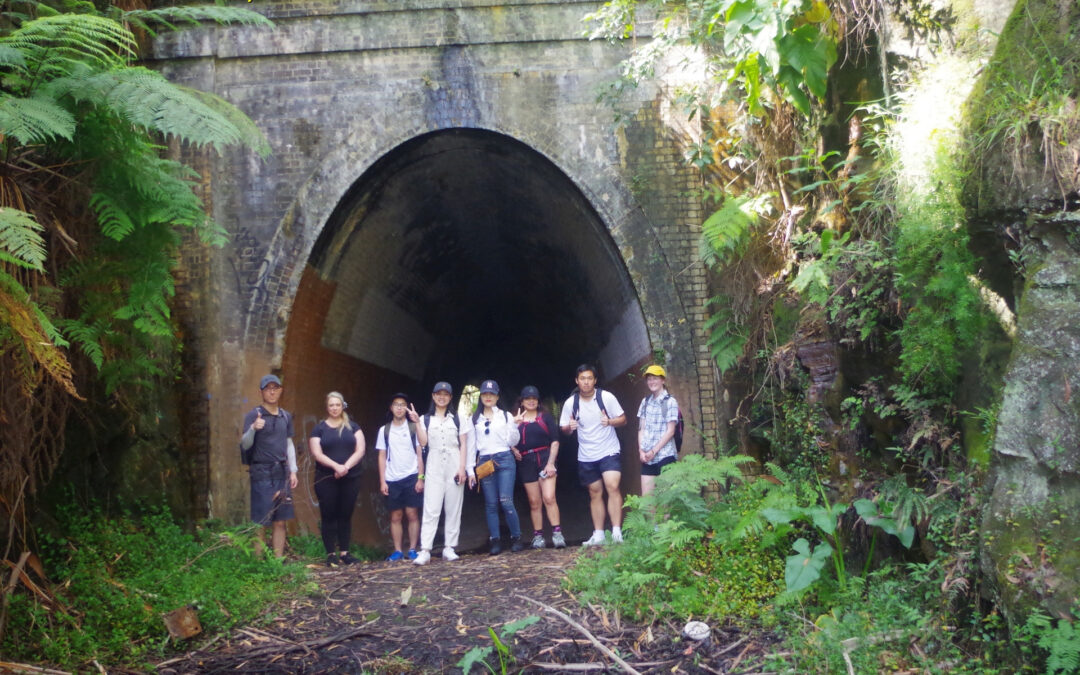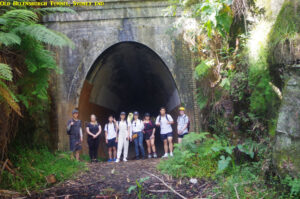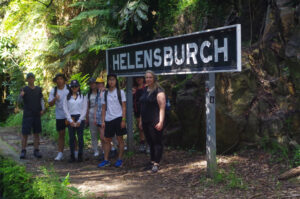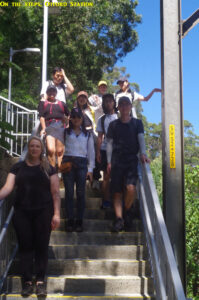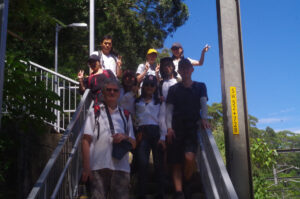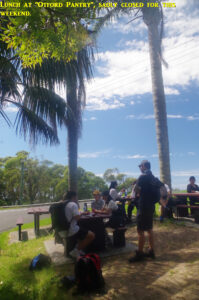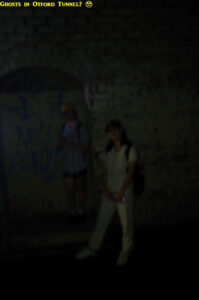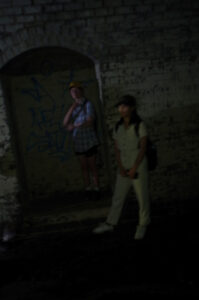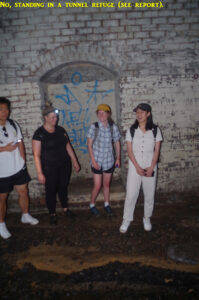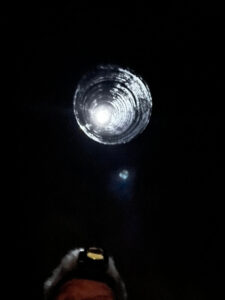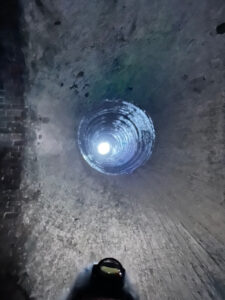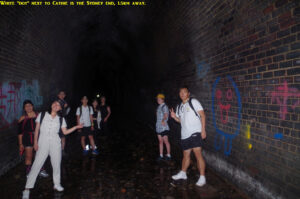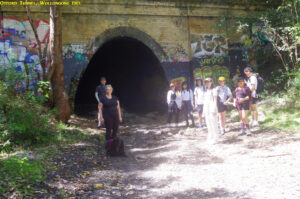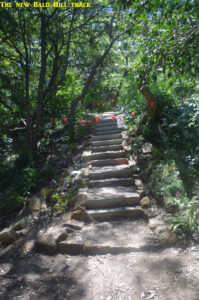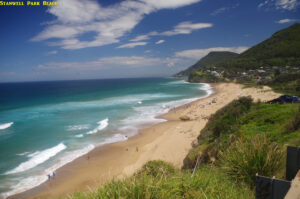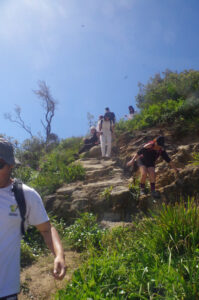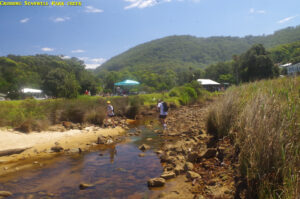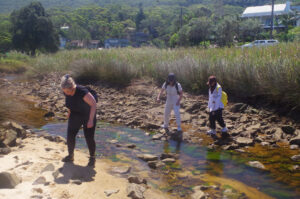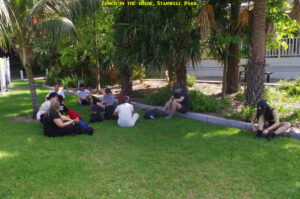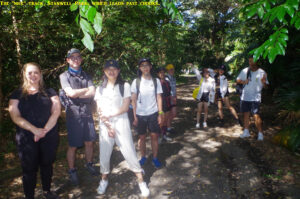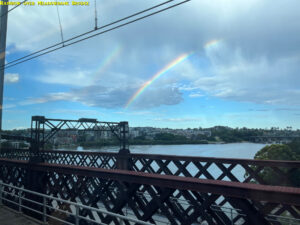Date: 26/2/2023
Trip leader: Bruce Stafford
Party: Abby, Brian, Cathie, Jarwen, Lishan, Maritza, Priya, Wei, Yulong (George).
Helensburgh to Stanwell Park Beach Sunday 26th February 2023.
The recent run of very warm weather limited where we could go in this walk, with areas away from the coast predicted to be 30 degrees C (and even 26 C in Katoomba). This walk, with its cool tunnels and largely shady tracks (except for the beach) provided a good choice on a hot day, as the predicted temperature on the coast was 27 degrees C.
So many of us met up at Central with Lishan and Abby getting on at Redfern and Cathie at Sutherland, Jarwen however missed the train and had to catch the next one to Otford to meet us there, so missed out on the first two tunnels. Thus nine of us got off at Helensburgh and after the obligatory toilet (not “bathroom”) break there headed off to the first tunnel which is the short Old Helensburgh Tunnel (80 metres long). It is not very exciting and the shortest of all the 8 former Illawarra Line tunnels, all bypassed by the realignment of the Illawarra Line by 1920 (except Clifton Tunnel [No.8] which still has trains). After a walk through that tunnel we headed for the nearby Metropolitan Tunnel which has glow worms. Apart from us there was just one other small group of three looking at this tunnel, but there was also a guy with surveying equipment there too, who was very non-committal about why he was surveying the tunnel. Made me wonder what officialdom might be planning for this tunnel. I am aware that some locals want a gate to be located right at the tunnel entrance, as the former gate near the old platform there could be too easily bypassed when locked. While posing at the “Helensburgh” sign on the old platform there, Cathie found that a leech was starting to climb on her foot, and it was removed. Cathie was the only one who got a leech on this walk (I guess they must like her).
So we went in to the point where the old rail tracks stop, and pleasantly finding it not too damp or muddy up to there. From there on the floor is very muddy and slippery so decided to go no further in. We turned off our torches and could see a few glow worms on the ceiling, but not as good as in past years. This 624 metre tunnel cannot be walked right through as the Wollongong end is blocked off by a coal mine at the other end. On our visit the sound of a water pump at that end was obvious and fairly loud.
Because our train to Helensburgh had run 10 minutes late, and the next train to Otford was not late, it reduced the time we had to spare to look further into the glow worm tunnel, so we had to return back to Helensburgh Station. We caught the next train to Otford, one stop down the line, and met Jarwen there, who was entangled in a large party of about 30 people also getting off, I assume headed for Figure 8 Pool. After a group photo on the stairs there, I lead my group down the track to Station Road and past the School to Domville Road, then up a fairly steep climb to reach the “Otford Pantry” shop on Lady Wakehurst Drive and hopefully some coffee. We were very disappointed to find it was closed until 12th March. Still, we took advantage of the tables and seats outside under the shade of two palm trees to have our lunch break.
After that, it was off to the third Tunnel, Otford Tunnel, which is the longest of the old 8 tunnels at 1.5km and until 1982 was the longest single track rail tunnel in Australia, although closed to trains in 1920. There is a bend at the Wollongong end in this otherwise straight tunnel which means that once inside, that end can’t be seen, and the Sydney (northern) end will appear as a shiny dot in the distance (see photo). There is a lot of rubbish on the tunnel floor from when it was used as a mushroom farm so care has to be taken not to trip on anything in the dark. Fortunately, unlike Metropolitan Tunnel, the drainage system seems to still work, so in most places it is dry and not muddy underfoot. It has no glow worms by the way. The halfway point is marked by a ventilation shaft which goes from the tunnel roof to the top of Bald Hill above, and on a sunny day like this day casts a weak light into the tunnel (see the two photos). I have been defeated in the past trying to take a photo of it with a SLR camera; the simple solution was to use the reverse function on the mobile phone camera (The black thing at the base of the photos is my headlamp). It looks quite surreal. Oh, and one other marker at the halfway point is a bath tub, so you can say that Otford Tunnel has a bathroom!
The interior of the tunnel was pleasantly cool compared to the outside temperature which was heating up by now; usually there is a slight breeze in the tunnel but not on this day. In fact that regular breeze contributed to the closure of the tunnel to trains in 1920. The tunnel floor rises towards Sydney on a 1 in 40 gradient, easy for walking but a challenge for a steam train going up it. The breeze meant that the hot exhaust from the locomotive simply followed it all the way up the tunnel, most uncomfortable for train crew.
At the exit we were back out at Chellow Dene Avenue, which here is just a rough bush track, with a new obstacle as a tree has fallen across the path. I haven’t mentioned the Bald Hill Track. At present it is undergoing a rebuild from Chellow Dene Avenue to the top of Bald Hill, which will mean that it will end up more like a tourist track rather than the rougher tracks favoured by some of our experienced SUBW walkers! It is part of the plan to have a continuous tourist standard track from Kamay National Park near Bundeena to Sublime Point above Austinmer. The present long overdue upgrade of the Coast Track from Burning Palms to Werrong Lookout is also part of this plan.
From Chellow Dene Avenue (which follows the original rail line, still on a 1 in 40 gradient) we made our way to “The Drive” and the little park and lookout over Stanwell Park Beach. We could see that there was only a fairly narrow part of the strand open to swimming as marked by the red and yellow flags. I asked a couple of the overseas students what the red and yellow flags were for, and they didn’t know. I explained to then that they mark the area where you must swim. Anyway after that we descended down the short cliff face track (see photo to the Stanwell Park Lagoon. A liocal asked why we were going the “hard way”, and we replied we were bushwalking! We could have continued down the roadway of The Drive but it’s a bitumen Road with no proper footpath; walking along the edge of the lagoon instead, and then crossing it, was cooler.
Normally I would have headed for a spot on the beach but as it was very warm in the sun, and half the group did not intend to swim, I opted to find a shady spot in the large park instead. Not easy as there were a lot of family groups there, but I found a nice shady spot located handily between the change rooms and the “Pantry” restaurant. I handed out that Australian delicacy to everyone: Lamingtons! The non swimmers stayed there and the swimmers headed for the beach. The sea was quite rough this day, explaining why only a limited section of the beach was safe for swimming. It was like leaping into a giant washing machine. Not only that, but the sea water temperature was about 23 degrees C, unusually warm. Mindful of the time until the next 2 hourly train departed Stanwell Park, I asked people to limit the time in the water, which they were happy to do anyway due to the rough conditions. Stanwell Park Beach has a 7/10 hazardous rating according to Surf Life Saving website https://beachsafe.org.au/
After the brief swim we returned to the others in the shade and I checked the train times; the Tripview app showed that the next train from Stanwell Park was running 27 minutes late! We could have had more time in the water after all! Still, it meant that we could – as on the previous walk here last November – walk to the station via the nice shady route and see some chooks (Gallus gallus domesticus) along the way. The chooks we saw last time were hiding under a tree in their yard, but the house next door also has chooks so we saw some in that yard. Then it was on to Station Street and the cafe on its corner of Lawrence Hargrave Road. A break was made here for ice creams and iced coffee (no one wanted any hot coffee in the heat), and then continued up the hill to Stanwell Park Station to await the train. The train continued to lose time all the way to Sutherland. I realised that I was thus going to miss my own Central Coast connection, so I opted to get off at Sutherland and look for a coffee shop open there for a break instead of hanging round Central doing nothing for almost an hour. There was nothing much open there as it was after 4pm by now, but as Cathie walked to where her car was parked she found that a charity group was giving out free tea and coffee and even some hot meals. We gladly took the coffee and sat down until it was time for me to get a local train from Sutherland.
In one way I did get some benefit from the train being late as a brief storm passed through the northern suburbs creating the rainbow I saw as my own train crossed Meadowbank Bridge (see last photo).
Everyone seemed to enjoy this walk which although not very long, took in some unusual locations. There is a third tunnel as well as a waterfall at Helensburgh to see if time ever permits, but that requires both an earlier train and cooler weather.
There was one “no show” on this walk which was a pity as he apparently has his own PBL, and it would have been interesting to see if it would work inside old railway tunnels (I assume you can test these for a connection without actually having to set off a distress signal).
One other thing I would mention is that I found that my headlamp was shining a rather weak light in the tunnels, and in Otford Tunnel I had to turn on the light in my mobile phone to supplement it; I would prefer not to do this as it runs down the phone’s battery. On returning home and testing the headlamp batteries, they were putting out only 1.3 volts each instead of 1.6 volts. A 0.3 volt difference doesn’t sound much, but it meant that all three together were putting out a total of 3.9 volts instead of 4.8 volts, and that made the lamp weak. So the lesson is, bring spare batteries on trips where you need to use a headlamp, just in case.
And I look forward to reading the trip reports from the other two walk leaders who had trips this same weekend!
My photos are below.
Cheers, Bruce Stafford

